^^ Watch the video above for an introduction to this lesson, and what else is coming your way.
Let’s get stuck in…
THE TRAFFIC “PROBLEM”
Let’s start by clearing up one common misconception: there is no shortage of traffic on the internet. In fact, there are more people online right now than ever before.
The problem isn’t lack of traffic. The problem is “getting attention”.
You’re competing against the millions of other options people have for spending their time – which means your window of opportunity is small. If you’ve ever run advertising campaigns on Amazon, you’ll know this first hand – if even 0.5% of people seeing your ad click on it, you’re doing incredibly well.
But this doesn’t mean getting traffic is inherently difficult – it just means you can’t throw up a book on Amazon, sit back, and watch the readers come pouring in. Instead, you need a firm idea of where you’re going to get that traffic and those clicks from.
At a basic level, you’ve got two options:
Depending on where you are in your journey, you might want to focus on one, or both of these options. There are, of course, inherent pros and cons to each. Specifically:
Putting the work in: this obviously requires you to dedicate time and effort to get results, and there are limits on how much you can scale this up. But these strategies are often cheap (or even free) to implement and can often get meaningful results very quickly. In other words, perfect if you’re just getting started with building up your marketing systems.
The “Traffic Store”: this option requires you to have an advertising budget, and you will need a very good idea of how much you’re going to earn from each click so you know how much you can spend and still be profitable. This can get expensive very quickly, can erode your profits (if you’re not doing it right), can be complicated to set up and maintain, BUT… this option can scale up almost indefinitely once you figure out profitability.
Now, we’re going dive much deeper into advertising options in a later lesson – because for the vast majority of authors, advertising platforms like Amazon Ads and Facebook Ads will only work well if “everything else” is working well first. In other words, you want to scale up something that’s already working and have some results under your belt. But, I will break down the main options for you today – then we’ll dive deeper into this later.
So in today’s lesson, we’re going to look at some effective strategies you can use to drive more traffic and clicks to your books – which will help grow your sales, your email list, your audience, and your exposure (without requiring a massive budget).
Let’s jump in…
![]()
We’re going to look at a few different approaches here – and the key thing to remember is you don’t have to (and probably shouldn’t) do ALL of these at the same time. Instead, pick one or two strategies from the “menu” I’m going to show you. Then you can move on to the other options later.
And because everybody’s circumstances are different, you might find some of these ideas will work better for you than others – which is completely normal. But I’ve deliberately chosen this “menu” because, broadly speaking, they get great results whatever genre you’re writing in (whether you’re a newbie or a seasoned pro – in fact, one author used just one of these strategies to get 140,000 new readers!).
In particular, we’re going to look at:
None of these strategies requires you to have a huge backlist of titles, a giant email list, or thousands of readers. You can use them whatever stage you’re at and see results. Starting with…
Underneath all the bells and whistles, Amazon is essentially a search engine. Specifically, it’s the third most-visited search engine in the world, and the largest “search engine for shopping”.
The good news? That means people browsing Amazon are already in a buying mood. The bad news? You’ve got millions of other similar titles to compete with.
One of the first things we need to do to “set up” your books in the right way, is think about how your work ties into the “search engine algorithm” that makes Amazon tick. In other words, how do we get Amazon to show your book to the right people at the right time?
Part of this means understanding how Amazon (and the other stores) catalogues your books, and that’s where “metadata” comes in. Specifically, keywords and categories.
On Amazon and the other stores, you can choose 2 categories in which you’d like to list your book during the publishing process.
Some good advice here – choose a category that’s as specific as possible, and as narrow as possible. If you’re writing “romance”, don’t choose “romance” as your category. Choose something like “romance -> paranormal romance -> werewolves and shifters”.
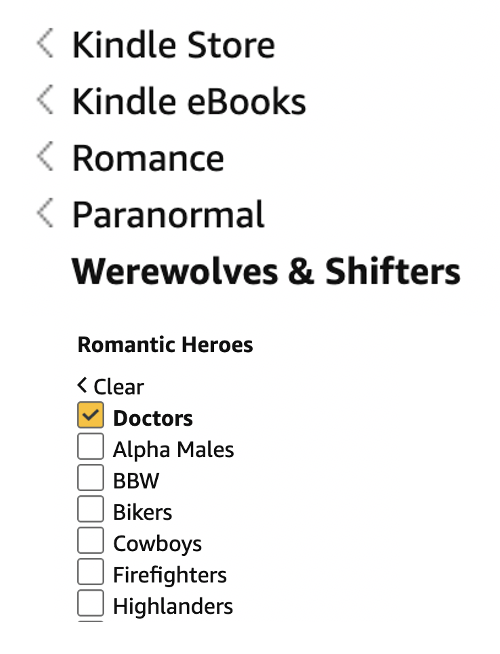
^^ for example. Obviously don’t choose that category if you write hard-boiled crime thrillers.
The sticking point: when choosing your categories, you’ll be limited to BISAC categories – in other words, “the categories that most high street bookstores recognise”. Which can be somewhat frustrating when the option you want isn’t available.
In which case, an easy solution – shoot an email to Amazon KDP Support (via your publishing dashboard) and ask them to manually add you to that category (spelling out the full path for them, as shown above).
Then you’ll be added to your category of choice within 24-72 hours. Easy! In fact, there are dozens of categories on Amazon that most people never even see – but your book can be listed in them. Contact KDP Support and they’ll be able to manually add you to as many as you like.
![]()
While your category choice will largely target readers who like to click through Amazon’s browsing options, your keyword choices will target readers who prefer to type search terms into the website.
There’s a similar principle here – choose a “keyword phrase” that’s as narrow as possible, while still giving you a decent amount of traffic (clicks).
This can be a little tricky to quantify – but here’s a quick run-through of what to look for:
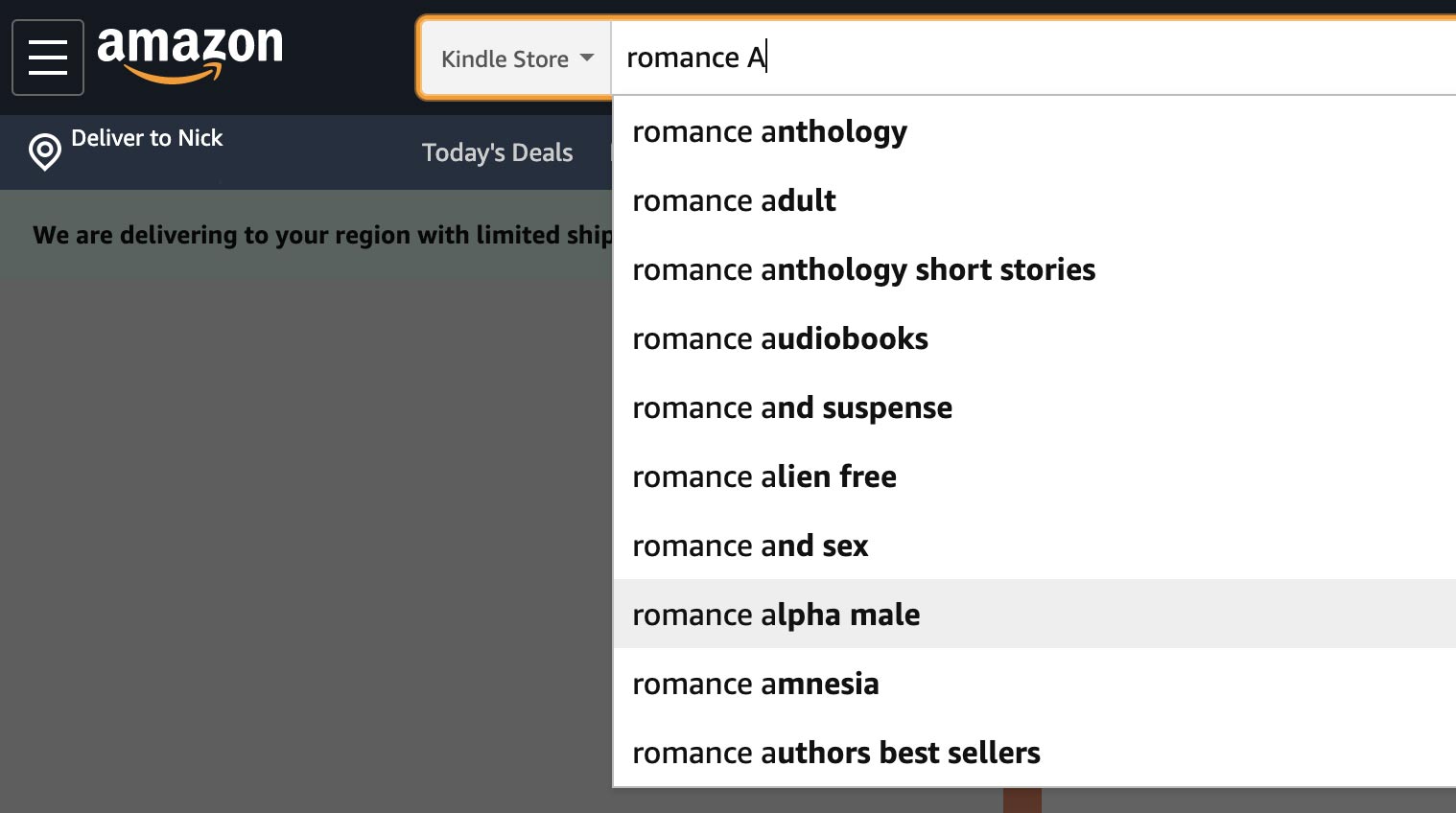
Start typing the “root keyword” of your book – for example, “romance” or “thriller”. Then see what suggestions pop up when you start adding letters (eg, “romance A”, “romance B”, “romance C”, etc).
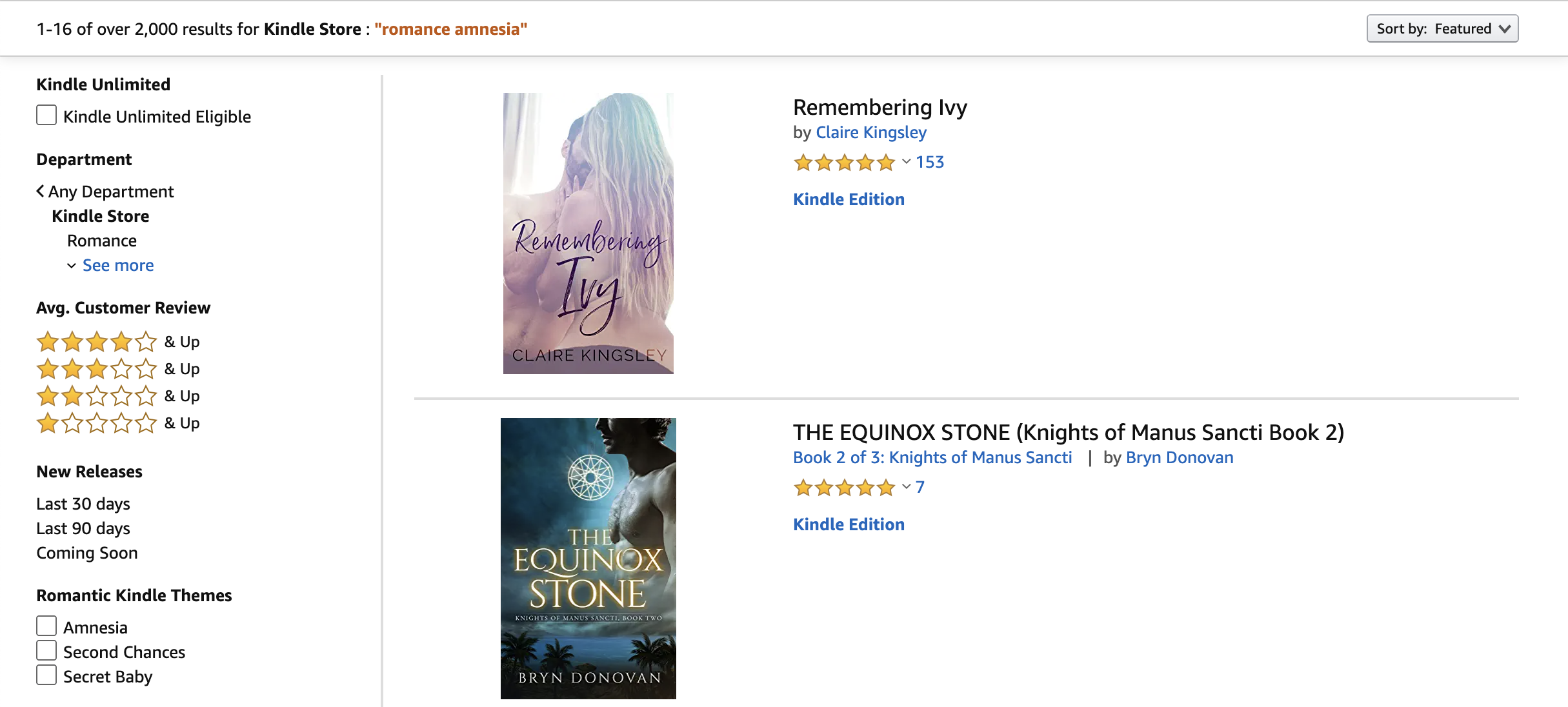
Click through to these suggestions and take a note of how many titles show up. You’re ideally looking for something with less than 20,000 other books.
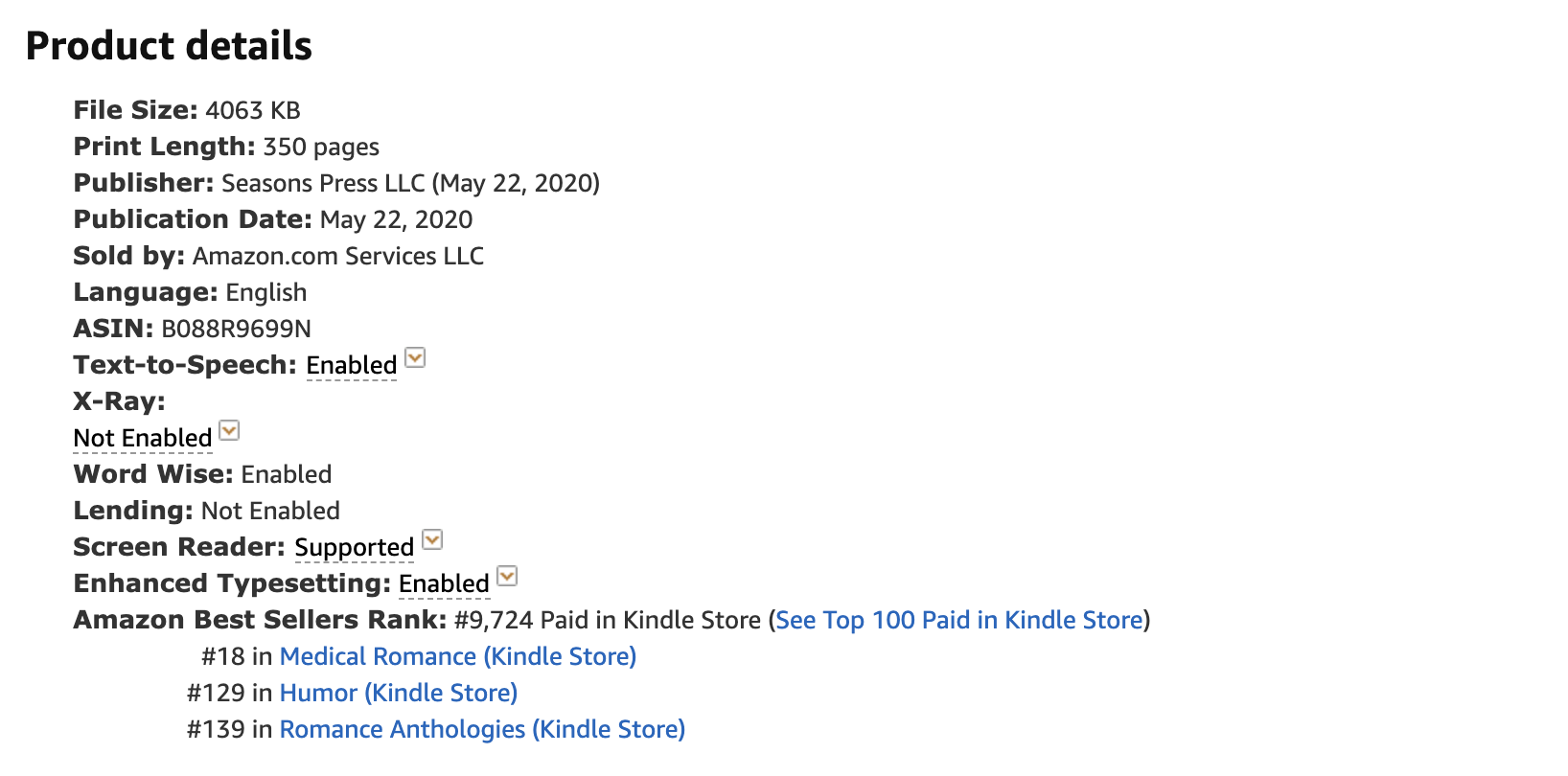
Finally, click through to the first 3-5 books on the page and check the sales rank. How are they selling? If those numbers suggest super-high blockbuster level sales, it might not be a good keyword choice (because you can’t compete – the higher selling books will appear higher up the page).
Similarly, if the sales are super low, that keyword phrase might not have enough traffic, so it might be a bad choice for that reason.
Tip: you can click through and check the sales rank of individual books, or you can just take a peek at the number of reviews. If all the books have good reviews, it might be worth clicking through to get more data. If all the books have very few (or zero) reviews, you can probably move on to your next keyword choice.
Once you’ve chosen 7 keyword phrases, add them to your publishing dashboard and you’re good to go!
You can also use some software like Publisher Rocket to do the keyword research for you. Choosing the right categories keywords can be helpful in getting your book noticed, and KEEPING it that way. In most cases, though, it isn’t a “magic bullet” by itself – you also have to drive traffic and sales to those books – but it can certainly help you stay as high in the charts as possible, for as long as possible. So don’t skip this part!

A free book gets downloaded 50 to 100 times more frequently than a paid one. If your “read through” is good, a decent number of those free downloaders will move through the rest of your catalogue (and join your email list).
You might remember the figures I shared with you in lesson one – where a 40% read through from book 1 to book 2 was the goal.
With permafree, that figure is lower. Usually single digit percentages. BUT… if we’re getting 50 times as many downloads to make up for it, even a 1-2% read-through rate can work well – so long as you’re getting the volume of downloads to support your revenue goals (check out the calculator in lesson one if you need to work these numbers out yourself).
If you’re not getting the volume of downloads you need, that’s okay – refer to the traffic strategies in this lesson and it will help bring that up.
You can even set your book to $0.00 permanently and set that up to run on autopilot. Best part? It costs you precisely… nothing.
Or, if your book is in KDP Select, you can run a free promotion for 5 days out of every 90 day enrollment period. BUT… you’ll need to pay for some ads to make that worthwhile (you’ll need hundreds – or thousands – of downloads over that 5 day period to make it worthwhile).
Here’s a helpful list from Dave Chesson of Kindlepreneur, with some places you can list your free book for extra exposure.
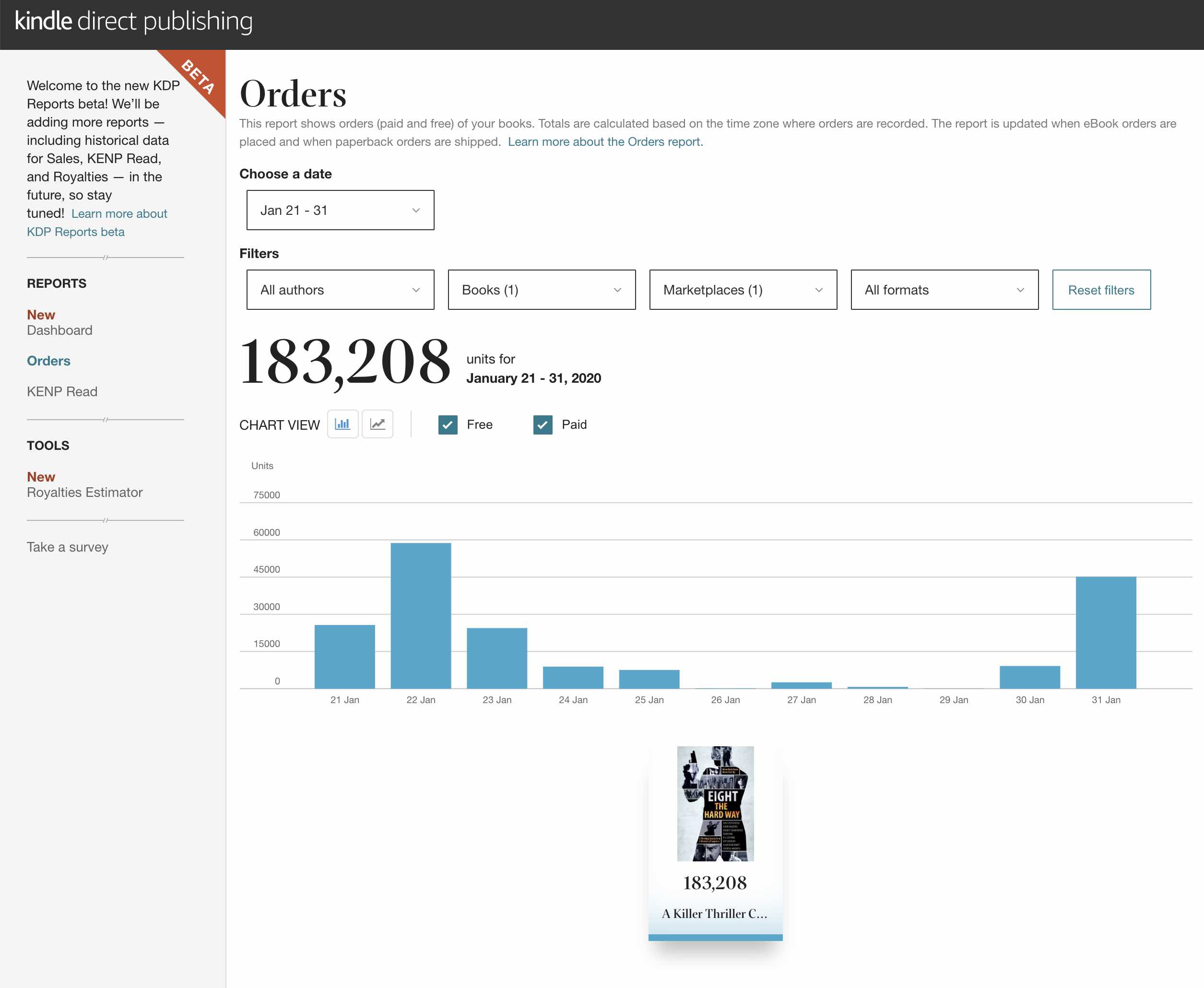 ^^ one of my books got nearly 200,000 downloads in a single month!
^^ one of my books got nearly 200,000 downloads in a single month!
So, like anything else, the effectiveness of permafree will depend on whether you’ve implemented the steps we talked about in lessons 1 & 2 – your permafree book still needs to have the right cover and description, and you still need to optimise for read-through (eg, writing in a series, linking to the next book, getting people onto an email list) and the numbers need to make sense.
But all things considered, permafree is an excellent way to start driving traffic IF you have all these things covered. And it costs nothing to get started (plus, it’ll give you a good idea of your read through).
Like Simone, who uses permafree to drive traffic to her multiple series:

^^ We looked at Simone’s results in more detail in Lesson Two. As you can see, the Free to Paid ratio isn’t far off 1:1 – which is a great result.
And fortunately, permafree is relatively simple to set up:
Or, if your book is in KDP Select and you want to run a free promo, just schedule that from your KDP dashboard – but be sure to have some ads or other promos set up to get as many downloads as you can (we’ll cover all those options here).
So, having a perma-free book is a great way to get the ball rolling, but what else can we do? Let’s take a look at some other traffic options…

With your Reader Magnet in place, and if you’re using “permafree” or free promotions on your books, you will start growing an email list pretty quickly. But how can you speed things up and make the most out of your subscriber list, regardless of how small it might be?
If you’re just getting started, chances are you don’t have a huge email list or an endless ads budget. So, how can you get traction faster?
With Joint Promotions, the basic premise is this: “What if, instead of spending 6 – 12 months building up an audience of your own, you could ‘borrow’ the audience of someone else?”
In practical terms… if you’ve got 300 people on your mailing list, Facebook page, Twitter account, whatever….
And you find 3 other people with a similar reach…
Next time you run a promotion or launch a new book, you’ll launch it to 1,200 people instead of 300.
The key is reciprocity. Offering value. Learning how to network effectively. No fancy advertising strategies, no super-wowza publicity stunts, no over-complicated psychoanalytical software and business automation…
Just good ol’ fashioned network building and working together.
“As an entirely unknown author, no mailing list, no back-catalog, nothing, I got sales and good reviews from the get-go.”
There are 4 approaches that deliver consistent results, regardless of what stage you’re at. They are:
Of course, building up a team of people to help you with joint promotions means getting out there and networking a little. Which can be scary (introvert alert!). Here’s a video breakdown that’ll help – how to cold-email any VIP:
You can also find other authors to work with over at BookFunnel.
Once you have 2-3 people you can team up with, you can start running these joint promo campaigns – and the more you run, the better your results will be:
“In the last 12 months alone, these promotions brought in 140,000 leads.”
Read Russell’s full experience with joint promo contests over at the blog here
Again, if you’ve implemented the steps we’ve covered already, you’ll stand a much better chance of getting great results – and the more you run these promotions, the more exposure you’ll get.
And if you don’t have an email list yet, don’t worry – here’s a quick way to jump-start one:

You can do these solo, or with promo partners (see above). The premise is simple – offer a sweepstake prize that your target reader would be interested in (e.g. – a bundle of books, a Kindle, etc.) and post your contest up on some giveaway directories.
There are hundreds of giveaway directories to choose from – GiveawayFrenzy is a great place to start – and you’ll start growing a list of entrants quickly.
Offer each entrant your Reader Magnet (we’ll cover more on this in the next lesson) and keep those people who click through to download it. Discard the rest. Once the contest is done, and you’re left with only the people who WANT to hear from you.
Here’s the process:
Consider what prize you can offer – the prize should be compelling (eg – worth $50 – $100 or more) and ideally relevant to the readers you want to attract. You definitely don’t want to offer cash or gift cards as a prize, unless you want to get flooded with awful quality entrants. I usually recommend starting off with offering a Kindle Paperwhite (or similar) e-reader device, as this will attract readers – if you pair this up with a bundle of ebooks (or paperbacks) in your genre (either yours, or someone else’s if they’re paper versions) this can help attract the right kind of readers.

^^ Choose something relevant and valuable
Use software – you want to be able to automate this as much as possible, and if you use software like UpViral or KingSumo Giveaways, there’s a feature built in where entrants can win extra points for sharing the contest with their social media following. This can increase the number of entrants by 30-50% (so it’s worth doing). You will also want to hook the contest software up to your mailing list provider so you can keep track of everyone.
Once the contest is set up, post the details on some giveaway directories. In some cases, you can pay a few dollars for “featured spots”, but you don’t have to.
When someone enters the contest, email them a confirmation and offer them a copy of your Reader Magnet (a free book you use to get people to sign up to your email list – we’ll cover this in more detail in the next lesson).
Offer your Reader Magnet again when you announce the winner.
Once the contest has ended, keep the people who downloaded your Reader Magnet (you can track the link clicks) and delete / unsubscribe everyone else to keep your list clean.
“I’ve grown my list by about six thousand with three giveaways, and I’m here to tell you it’s pretty awesome.”
Read CJ’s Full Experience With Contests Here
And voila! Lots of new readers joining up on your email list. Easy! And while these promotions do cost money (although not a huge amount), we found our cost per subscriber was about 10x lower versus paid ads. A great result.
![]()
Popping down to the “traffic store” is a great option if you need to get lots of clicks in a short period of time (or you want to schedule a burst of traffic on a specific date).
In general, paid ads will fall into two categories:
With the former, you pay a fee to have your book listed in a daily email that goes out to the ad provider’s email list. Pricing for this will vary, and so will results, but if you line up 3-5 of these during a launch or promotion week, it can have some great results.
Check out Kindlepreneur’s List of Email Blast Ad Providers here
For the latter, most likely you’ll be looking at Amazon Advertising, Facebook Ads, and BookBub (self-serve) ads. These platforms allow you to bid for clicks, and you can set up campaigns to run 24/7.
Essentially, you’ll pay a fee for each click (or thousand impressions) and you’ll be able to target your ads to the people most likely to be interested in them.
Exactly how these platforms work – and how to know when you’re ready to start investing in them – will be the subject of a future lesson (far too much to cover here). But for now, just keep them in the back of your mind, and consider applying for a featured spot with one of the Email Blast providers if you’ve got a launch or promotion coming up.
^^ they’re easy to use – just click through to the site you want to use and fill in their form.
Although one downside is that almost all these sites require your paid book to be discounted – so it’s not something you can use all the time (only when you’re running a promotion or if you have a permanently free book).
Now, we’ve covered a LOT in today’s lesson. And remember, you shouldn’t try to do ALL these things at once. Think of it like a “menu” of options – choose one or two to focus on at a time.
I’ll also be releasing an invitation to join me in an on-demand workshop soon, where we’ll cover everything we’ve touched on so far in more detail. So keep your eyes open for that.
In the next lesson, we’ll take a look at how to grow your business’ most important marketing asset – your email list. If you ever want to hit a bestseller list, automate your sales growth, and get hundreds of five-star reviews, you’re going to need one…
In the meantime, check out this lesson’s summary and action items below – and drop me a line in the comments if you have questions!
This section is a little shorter today: Now you know how many clicks you need per day (and your books are properly optimised for them) it’s time to start getting some traffic.
There are several effective ways to start driving clicks to your books and website – and the best approach is to choose 1 or 2 strategies and work through them (rather than doing everything at once).
And remember – the things we cover in this lesson are designed to get you CLICKS. What happens after the click (eg – someone buying the book) is going to depend on how well you’ve implemented the previous lesson.
In the meantime, leave a comment below if you have questions!